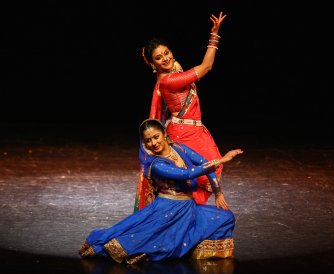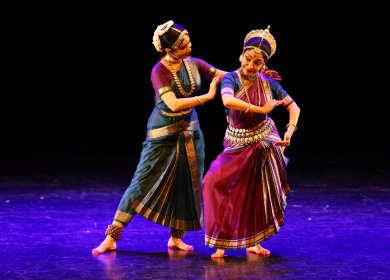
|   |

|   |
Strength, thy name is woman - Shereen Saif e-mail: shereen.saif@gmail.com Photos courtesy: Tambourine Live April 5, 2016 International Women’s Day on 8th March is commemorated the world over in a multitude of ways. Dubai based events and entertainment company Tambourine Live, played on the theme by hosting ‘Shakti’ – their annual tribute to strong and distinguished women in the performing arts arena. This year’s ‘Shakti’ held at the Dubai Community Theatre and Art Centre panned out as a 2-part show with a stellar lineup featuring dancer-actor Aditi Bhagwat and for the first time together in Dubai, classical dance legends Alarmel Valli and Madhavi Mudgal. With the promise of the finest in Kathak, Lavani, Bharatanatyam and Odissi, the show had attracted a sizeable pool of connoisseurs and dance enthusiasts from the Indian diaspora and a decent sprinkling of curious Arab and Western expats. A thrilling Kathak-Lavani confluence Pop culture version of Lavani, the 17th century Maharashtrian folk dance, is rather crude. The stereotypical buxom dancer in a flashy paithini, the lewd latkas and jhatkas, lyrics dripping in double entendres and the overt sensuality has become its distinguishing trademarks. History however speaks of a Lavani that like any other folk dance form had a cathartic and therapeutic social role to play. Through music and dance, it tackled political, social and romantic themes and connected with the common man. Through Lavani, women boldly expressed their sensuality and spoke of their intimate feelings. In war torn Maharashtra during the 18th and 19th century, it entertained and lifted the morale of soldiers going to battle. However, following the decline of the Peshwa rule and with it the royal patronage that it enjoyed, the dance form fell out of favour, became marginalized and slowly degenerated into ‘nautch’. Artists like Aditi Bhagwat are among those working towards the mainstream revival of Lavani. For ‘Shakti,’ Aditi and her dancers put together a thematic presentation, blending Lavani and Kathak with the idea of comparing and contrasting the two styles. In the artist’s own words, a showcase of ‘Kathak chi Adaa, Lavani cha Thumka’ - the finesse and grace of Kathak juxtaposed with the bold and fiery moves of Lavani. The Act opened with “Aigiri Nandini,” a salutation to the feminine divine. One has seen several choreographic versions of this Mahishasuramardini stotram but a Kathak-Lavani presentation was a refreshing first.  Aditi Bhagawat & group  Aditi Bhagawat & Harshada Jambekar Following a short introduction to give the audience a contextual background to Lavani, Aditi launched into a mujra – a courtesan style salutation to the mehfil, supported by two of her Lavani dancers. Sashaying on stage, their heads covered by the pallus of their dazzling nauvaris, the dancers, as is typical in the Lavani tradition, gently teased the audience before revealing themselves with a flourish. After curtsying the audience in the customary Maratha way (a deep bow with three rapid scoops of the right hand), the dancers executed a lively piece with energetic movements and footwork, building in tempo and finishing in a surprising drop-freeze. Moving into more abhinaya prominent pieces, Aditi and her dancers engaged the audience with the sensual classic “Rajasa javali jara basa” rendered by Lata Mangeshkar and the Krishna thumri “Jamuna mein kaise jaaon mein saiyyan.” Switching back to nritta intensive choreography, the group presented their penultimate piece - a crisp and visually delightful Tarana with footwork, chakkars, paltas, chaals and nuanced movements. The showcase concluded with a brilliant Kathak-Lavani jugalbandi between Harshada Jambekar, the sole Kathak dancer in the group and Aditi Bhagwat. Choreographed as a conversation in foot percussion between Kathak and Lavani complimented with the rhythmic play between the tabla and the dholki, the piece was a demonstration of the similarities and stylistic differences between the two sister dance idioms. Aditi was an irrepressible force to reckon with. Her electrifying presence, impeccable sense of rhythm and drama had the audience on edge. As Act One drew to a close, one came away with a renewed perspective on Lavani, somewhat denting its Bollywood stereotype. Beyond its innate sensuality and erotic content, one was able to appreciate its technical brilliance and see how it could stand its ground against a classical dance form like Kathak. Kudos to Aditi Bhagwat and co! Coming together in harmony The second and main act of ‘Shakti’ was a collaborative creation by two of India’s foremost classical dancers, Madhavi Mudgal and Alarmel Valli. Titled ‘Samanvaya’, the presentation was a seamless meeting point of their respective styles – Odissi and Bharatanatyam. A fruit of two decades of joint exploration and deliberation, Samanvaya was unlike any jugalbandi the audience had ever experienced. Retaining the uniqueness of their dance styles, the dancers had found a common ground to come together like two halves of a whole. After having travelled the world, the much-touted production and its legendary creators were coming to Dubai for their first showing and this had created a great deal of anticipation particularly among the dance fraternity.  Alarmel Valli & Madhavi Mudgal
The presentation opened with the Prithvi Suktam, where potent verses from the Atharva Veda extolled nature’s splendor and invoked the Earth as the bountiful sustainer of all that lives. Offering flower petals to the sacred ground on which they danced, the artists gently eased and unfurled, together weaving a tapestry of movements with much gravitas. A solo by Madhavi Mudgal followed suit. The chosen piece was a vintage Pallavi choreographed by Guru Kelucharan Mohapatra with music composed by Pandit Bhubaneswar Mishra. A play of rhythms and visual patterns, the piece explored the architectonics of the Odissi technique and Madhavi executed it in her unhurried, Zen demenour. Alarmel Valli responded with a solo piece inspired from Sangam literature. Portraying a delicate moment of transition from childhood to adolescence, Unnuneer from the Kalithogai anthology had the distinction of being the first ever Sangam poem she’d choreographed. The piece spoke of the first stirrings of romantic feelings in a young girl when she recognizes the handsome stranger at the door to be the impish troublemaker from her childhood. Through her deft storytelling, Valli created an amusing dynamic between the giggly mugdha nayika, the provocative hero and the unsuspecting mother. The piece concluded with the young lad shooting naughty glances at the girl, leaving much to the imagination of the audience. Following their solos, the dancers once again came together in a Kshetrayya padam where the bitter nayika chides Krishna for his dalliance with another woman. The crowing glory of the presentation was a duet entitled ‘Samanvaya’ where not only the dance but also the musical genres (Hindustani and Carnatic) came together in a composition by Madhup Mudgal and Prema Ramamurthy. The geometrical lines of Bharatanatyam perfectly blended with the sensuous lyricism of Odissi, neither styles dominating the other. A fine balance of energies, the piece felt like one was watching the physical manifestation of Yin and Yang. Special credit to Murugan Krishnan, Chennai’s most sought after lighting wizard, for accentuating the magic of the production and creating a heighted experience. Jugalbandis have been in vogue for years now but sadly most dancers launch into a collaboration without a solid understanding of their own genres, let alone the dance form of their counterparts. The result is often like a dish where the ingredients don’t combine to create a tasteful whole. ‘Samanvaya’ is a fine example of visual and aural harmony between two Indian classical dance forms. And this was not created overnight. Both the dancers spent years steeping in and enriching their respective dance traditions before they came together organically to create something. It helped that both had had some initiation in the other’s dance form but more importantly, they shared a similar aesthetic vision and the intent to find a common ground for articulation whilst maintaining the purity of their individual styles. This is why Samanvaya is a class apart – perhaps even a fete that is hard to replicate. Closing on a deviant footnote…Hamlet in his misogynistic soliloquy once branded women as frail. Today, 400 years after Shakespeare’s death, one hopes the world sees women as they truly are – potent embodiments of Shakti. Happy Women’s Day. Everyday. Shereen Saif is a dancer, theatre professional, creative movement advocate and PR consultant based in Dubai. She is a Mohiniattam disciple of Dr. Neena Prasad and pursues her training in traditional theatre techniques under veteran Kutiyattam exponent Venu G. |